Integrated Sustainability ReportPerformance
Environmental
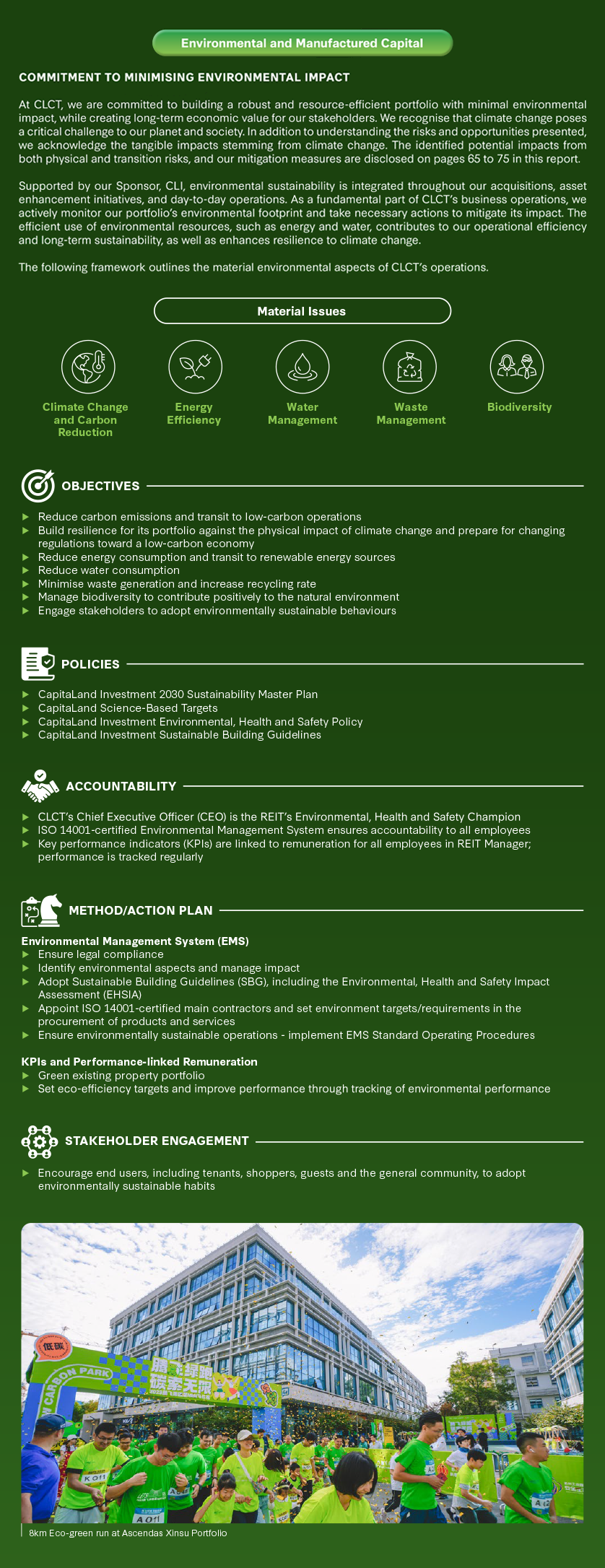
CLCT’s Environmental Targets
The 2030 SMP outlined the CLI Group’s 2030 targets and pathways to transit to a low-carbon business, improve resource use and enable a circular economy. As a CLI-listed REIT, CLCT has incorporated KPIs, most of which are linked to remuneration for all employees in the REIT Manager, including top management. Concurrently, we continue to actively engage stakeholders and implement various measures to achieve these targets.
2030 SMP TARGETS AND CLCT’S PERFORMANCE
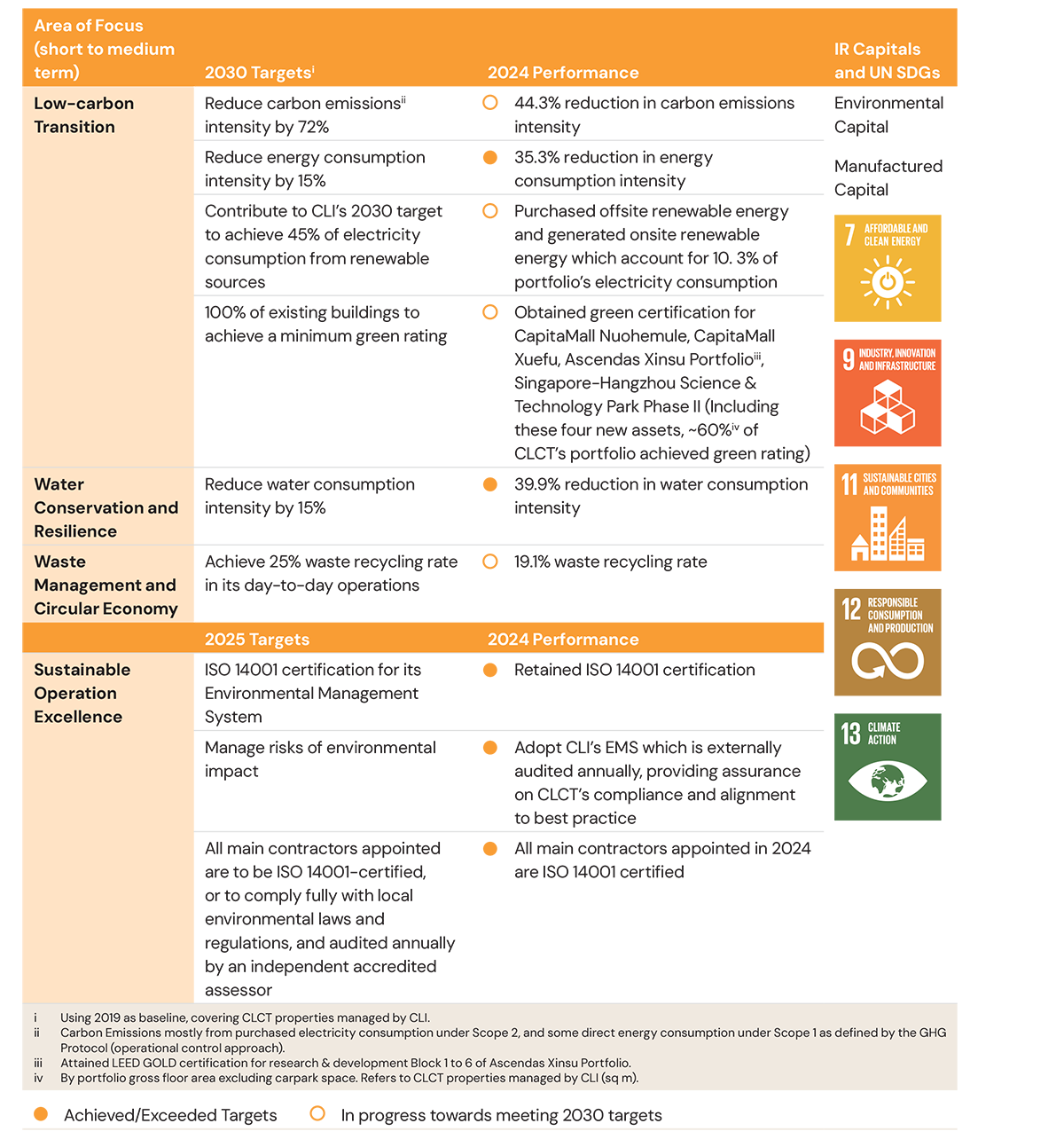
Top Management Commitment and Employee Involvement
CLCT’s Sustainability Management Committee (SMC) is led by CLCT’s CEO and supported by key management team members that oversees the REIT’s sustainability objectives and strategies directly. Supporting the SMC is CLCT’s Sustainability Working Committee (SWC), which collaborates closely with CLI’s EHS Committee to implement sustainability-related initiatives across its operations.
Key Performance Indicators (KPIs) Tied to Remuneration
The remuneration for all employees in the REIT Manager, including top management, is linked to CLCT’s environmental targets through KPIs. Employees are actively encouraged to report environmental-related issues and complaints, as well as instances of non-compliances and non-conformities.
Tracking Our Environmental Results
Environmental Tracking System (ETS)
Since 2008, we have monitored the energy and water usage, waste generation and carbon emissions of our managed and owned properties through CLI’s ETS. CLCT leverages this platform to survey the various environmental initiatives implemented at its properties globally including energy and water efficiency measures, biodiversity and habitat risks, as well as physical risks that include flood risk and water management initiatives.
The cloud-based ETS platform enables benchmarking of consumption patterns and identifies opportunities for operational efficiency improvements. It allows properties to analyse consumption against targets and past trends, make regional comparisons, and pinpoint areas for improvement. The data is also analysed against reduction targets, thereby enhancing the understanding of consumption patterns and identification of eco-efficiency opportunities in CLCT’s portfolio. Regular desktop audits are conducted to ensure data accuracy and completeness.
Climate Change Strategy
Climate change presents one of the most significant challenges of our time, with far-reaching implications for businesses, communities and ecosystems. CLI and its REITs recognise the need to take action to mitigate its environmental impact and adapt to emerging risks. CLI started to align its climate-related disclosures with the TCFD recommendations in the four key areas of governance, strategy, risk management and metric and targets since 2017 and further declared its support for TCFD and its recommendations in 2019. With the publication of the ISSB IFRS S2 Climate-related Disclosures, CLI and its REITs, including CLCT, strive to continuously enhance its climate-related disclosures as aligned with international best practices.
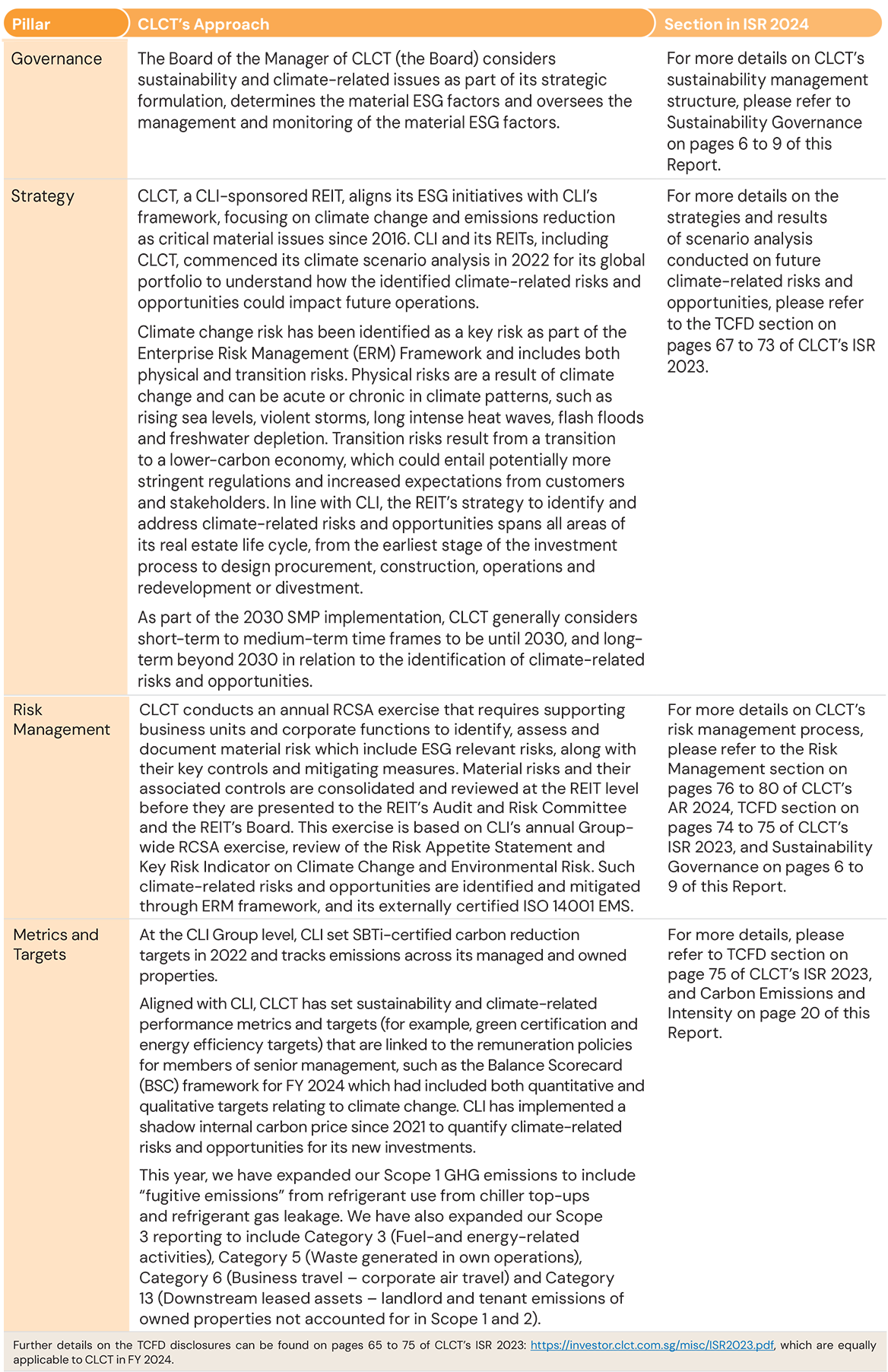
Carbon Emissions and Intensity

As a CLI-listed REIT, CLCT is aligned to CLI’s commitment to reduce carbon emissions of its operations with a 1.5°C trajectory16, with an aim to achieve Net Zero Scope 1 and 2 emissions by 205017. In line with the CLI Group, CLCT takes guidance from the operational control approach as defined by the GHG Protocol Corporate Standard to calculate its carbon emissions.
In 2024, CLCT’s total Scope 1 and 2 GHG emissions was 41,089 tCO2e. This translates to a carbon emissions intensity of 29.6 kgCO2e/m2, a 44.3% reduction compared to 2019 baseline. On a year-on-year (YoY) basis, Scope 1 GHG emission increased by approximately 3 times the amount in 2023 due to the inclusion of fugitive emissions from refrigerants top-up, in line with CLI’s latest practice. However, CLCT’s total Scope 1 and 2 GHG emissions intensity recorded a slight decrease of 2.2% YoY, driven by the purchase of PPA and onsite renewable energy generation from onsite solar plants.
Aligning with CLI, we have also expanded our Scope 3 emissions categories and it amounted to 120,826 tCO2e in 2024. Please refer to GHG Emissions Data Methodology in the Appendix for more details.
Energy Consumption, Intensity and Renewables

Improving energy efficiency and implementing onsite and offsite renewables are the most impactful and cost-effective ways to mitigate emissions. In 2024, the total energy consumption of operational properties was 92,880 MWh. This translates to an energy consumption intensity of 66.8 kWh/m2, a 35.3% reduction compared to 2019 baseline. On a YoY basis, CLCT’s energy consumption intensity recorded a slight increase of 1.1%, due to the climate change, characterised by warmer summer and colder winter within China, as well as the expanded scope of data collection for district heating in CapitaMall Aidemengdun & CapitaMall Nuohemule.
As a CLI-listed REIT, CLCT implements various energy conservation measures including:
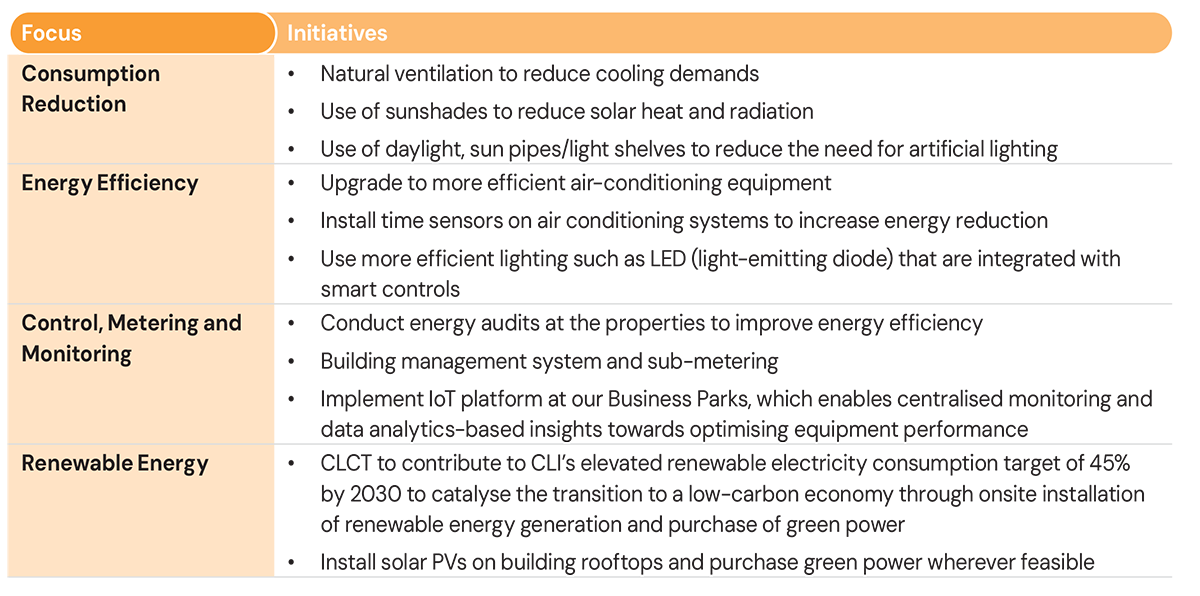

Water Consumption and Intensity

CLCT adopts a strategic approach to water management in its portfolio and is committed to reducing water consumption. A regular survey is conducted to better understand water source and discharge from each property. At all CLCT’s properties, the primary source of water withdrawal is from municipal resources and wastewater is responsibly disposed of through municipal facilities.
In 2024, CLCT’s total water consumption was 719,969 m3. This translates to a water consumption intensity of 0.52 m3/m2, a 39.9% reduction compared to 2019 baseline.
On a YoY basis, CLCT’s water consumption intensity recorded a slight decrease of 0.2%. The majority of CLCT’s water usage comes from cooling towers, toilets, washing activities and landscaping.
As CLCT’s properties are mostly located in medium to extremely high-water stress areas18, we continue to implement initiatives to ensure efficient operations and minimise water wastage. These conservation initiatives have been rolled out in CLCT’s retail malls and business parks:

Our property managers conduct routine assessments of facilities to monitor water usage, promptly identifying and addressing any fluctuations or anomalies. CLCT organises quarterly operational meetings with tenants and employees to enhance water-saving awareness, reinforcing the significance of water conservation and sharing reduction measures with stakeholders.
Waste Management
CLCT prioritises responsible waste management by engaging stakeholders, including tenants and the public, to reduce and recycle waste. Recycling and disposal bins for different waste types are strategically placed across properties for ease of use and to encourage recycling.
Main contractors are required to minimise waste and ensure proper disposal. Property management teams track waste collection and recycling efforts. CLCT also promotes eco-friendly practices, such as returning used toner cartridges and using Forest Stewardship Council (FSC)-certified paper. To further support sustainability, CLCT’s ISR is made available online, eliminating the need for printing.
In 2024, CLCT collected a total of 7,701 tonnes of waste, of which 19.1% (equivalent to 1,470 tonnes) were recyclable waste comprising paper, plastic, metals and other materials. Zero tonnes of hazardous waste were collected in 2024.
17 This refers to net greenhouse gas emissions. For more information on greenhouse gases covered by the target, please refer to the GHG Emissions Data Methodology.
18 The water stress areas were computed using the World Resources Institute (WRI) Aqueduct Water Risk Atlas (wri.org).
Environmental Performance Highlights
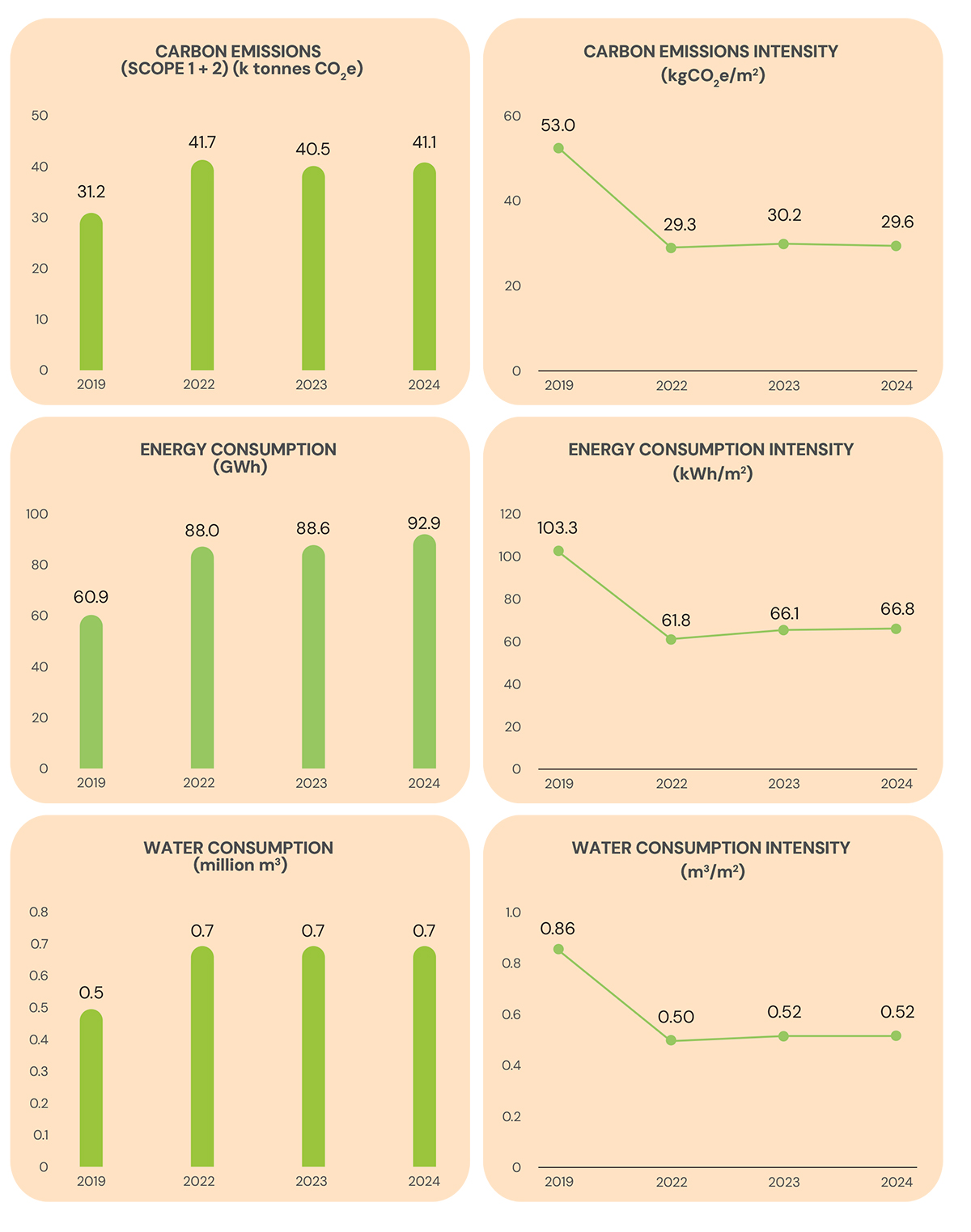

 Social
Social
 Governance
Governance